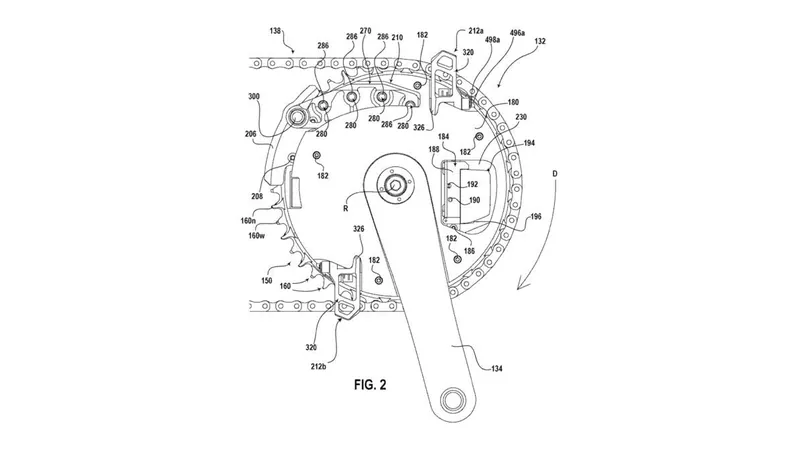
Revolutionizing Cycling: SRAM's Groundbreaking Chainring-Integrated AXS Front Derailleur Patent Unveiled!
2025-01-29
Author: Lok
SRAM’s Bold Step into Cycling Innovation
SRAM has taken a bold step into the future of cycling by securing a patent for an innovative front shift mechanism specifically designed for a 2x drivetrain. This cutting-edge technology integrates the derailleur directly into the crankset, eliminating the need for traditional derailleur mounts. Published in 2020, the patent details a wireless, electronic derailleur powered by an AXS battery strategically located on the chainring.
Imagine a bike without the cumbersome front derailleur—this is what SRAM is envisioning. By housing the shifting mechanism on the chainring, the design aims to streamline bike setups, potentially improving aerodynamics and reducing frame turbulence that can hinder performance.
While SRAM isn’t entirely new to eliminating front derailleurs (remember the Truvativ Hammerschmidt from 2008?), this new patent takes the concept further. Unlike the Hammerschmidt's sealed system—where only one chainring faced the elements—this design is more exposed, adding a layer of complexity but also versatility to cycling gear.
Patent Confirmed: The Future Is Here!
Filed back in 2019, SRAM's patent was officially granted on January 8th, sparking excitement in the biking community. However, it’s essential to approach this news with a mix of enthusiasm and caution—patents don’t guarantee immediate market availability. Oftentimes, they are filed to protect intellectual property without plans for immediate production.
How It Works
The heart of this technology lies in its ingenious shifting mechanism. For downshifts, two hinged paddles located on the big chainring engage the chain, guiding it smoothly from the larger to the smaller chainring. This operational design effectively allows for two downshifts per crank revolution.
Conversely, the upshift mechanism employs a series of guide pegs that lift the chain from the small to the big chainring, providing a single opportunity for upsizing the gear with each crank turn. This careful engineering raises questions about the efficiency and speed of the shifts compared to traditional derailleur systems.
Why Make the Change?
So, why would SRAM invest in such a sophisticated solution? There are compelling reasons beyond aesthetic innovation. One major advantage is the elimination of specific frame design constraints. For instance, bikes like the Rondo Ruut 2.0, which employs an unconventional seat tube design that disallows a traditional front derailleur, would finally gain access to enhanced gear options with this new integration.
In addition, by moving components onto the chainset, there’s potential for increased tire clearance, paving the way for wider tires that many cyclists are increasingly favoring for gravel and road biking.
Considerations to Ponder
For those concerned about maintenance, there's a silver lining—this system is modular. This means that while chainring replacements should remain straightforward, adjustments might be more complex when it comes to changing chainring sizes due to the specific nature of the upshift apparatus.
On the downside, shifting speeds may not match the current high standards set by traditional systems, particularly in upshifting, which occurs once per crank rotation. Additionally, while SRAM's concept does show promise for improved shift accuracy by reducing misalignment risk, the open design raises durability questions when it comes to exposure to dirt and debris, likely making it more suitable for road cycling rather than rugged terrains.
The Bigger Picture
This innovation holds the potential to reshape bike frame designs profoundly. Engineers and manufacturers may now have more freedom to experiment with new tube shapes and designs, especially for aerodynamic road bikes, triathlons, and time trials. As the cycling world eagerly anticipates practical implementations of this patent, one thing is clear—SRAM's leap into integrated shifting could very well catalyze a new era for performance cycling.
Stay tuned as we watch this rollercoaster of innovation unfold!


 Brasil (PT)
Brasil (PT)
 Canada (EN)
Canada (EN)
 Chile (ES)
Chile (ES)
 Česko (CS)
Česko (CS)
 대한민국 (KO)
대한민국 (KO)
 España (ES)
España (ES)
 France (FR)
France (FR)
 Hong Kong (EN)
Hong Kong (EN)
 Italia (IT)
Italia (IT)
 日本 (JA)
日本 (JA)
 Magyarország (HU)
Magyarország (HU)
 Norge (NO)
Norge (NO)
 Polska (PL)
Polska (PL)
 Schweiz (DE)
Schweiz (DE)
 Singapore (EN)
Singapore (EN)
 Sverige (SV)
Sverige (SV)
 Suomi (FI)
Suomi (FI)
 Türkiye (TR)
Türkiye (TR)